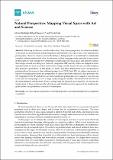Files in this item
Natural perspective : mapping visual space with art and science
Item metadata
| dc.contributor.author | Burleigh, Alistair | |
| dc.contributor.author | Pepperell, Robert | |
| dc.contributor.author | Ruta, Nicole | |
| dc.date.accessioned | 2020-11-03T13:30:03Z | |
| dc.date.available | 2020-11-03T13:30:03Z | |
| dc.date.issued | 2018-05-07 | |
| dc.identifier | 270971131 | |
| dc.identifier | 0703ec0d-0065-44e2-a968-81de351c298e | |
| dc.identifier | 85079650927 | |
| dc.identifier.citation | Burleigh , A , Pepperell , R & Ruta , N 2018 , ' Natural perspective : mapping visual space with art and science ' , Vision , vol. 2 , no. 2 , 21 . https://doi.org/10.3390/vision2020021 | en |
| dc.identifier.issn | 2411-5150 | |
| dc.identifier.other | ORCID: /0000-0001-5300-2913/work/82788919 | |
| dc.identifier.uri | https://hdl.handle.net/10023/20892 | |
| dc.description.abstract | Following its discovery in fifteenth-century Italy, linear perspective has often been hailed as the most accurate method of projecting three-dimensional visual space onto a two-dimensional picture plane. However, when we survey the history of European art it is evident that few artists fully complied with its mathematical rules, despite many of them being rigorously trained in its procedures. In this paper, we will consider how artists have actually depicted visual space, and present evidence that images created according to a “natural” perspective (NP) used by artists are judged as better representations of visual space than those created using standard linear (LP) and curvilinear fisheye (FP) projective geometries. In this study, we built a real three-dimensional scene and produced photographs of the scene in three different perspectives (NP, LP and FP). An online experiment in which we asked people to rank the perspectives in order of preference showed a clear preference for NP compared to the FP and LP. In a second experiment, participants were asked to view the real scene and rate each perspective on a range of psychological variables. Results showed that NP was the most preferred and the most effective in depicting the physical space naturally. We discuss the implications of these results and the advantages and limitations of our approach for studying the global metric and geometrical structure of visual space. | |
| dc.format.extent | 3395192 | |
| dc.language.iso | eng | |
| dc.relation.ispartof | Vision | en |
| dc.rights | Copyright © 2018 by the authors. Licensee MDPI, Basel, Switzerland. This article is an open access article distributed under the terms and conditions of the Creative Commons Attribution (CC BY) license (http://creativecommons.org/licenses/by/4.0/). | en |
| dc.subject | Art | en |
| dc.subject | Visual space | en |
| dc.subject | Perspective | en |
| dc.subject | Natural perspective | en |
| dc.subject | Geometrical perspective | en |
| dc.subject | Peripheral visual field | en |
| dc.subject | N Visual arts (General) For photography, see TR | en |
| dc.subject | NDAS | en |
| dc.subject.lcc | N1 | en |
| dc.title | Natural perspective : mapping visual space with art and science | en |
| dc.type | Journal article | en |
| dc.contributor.institution | University of St Andrews.School of Divinity | en |
| dc.identifier.doi | 10.3390/vision2020021 | |
| dc.description.status | Peer reviewed | en |
This item appears in the following Collection(s)
Items in the St Andrews Research Repository are protected by copyright, with all rights reserved, unless otherwise indicated.

